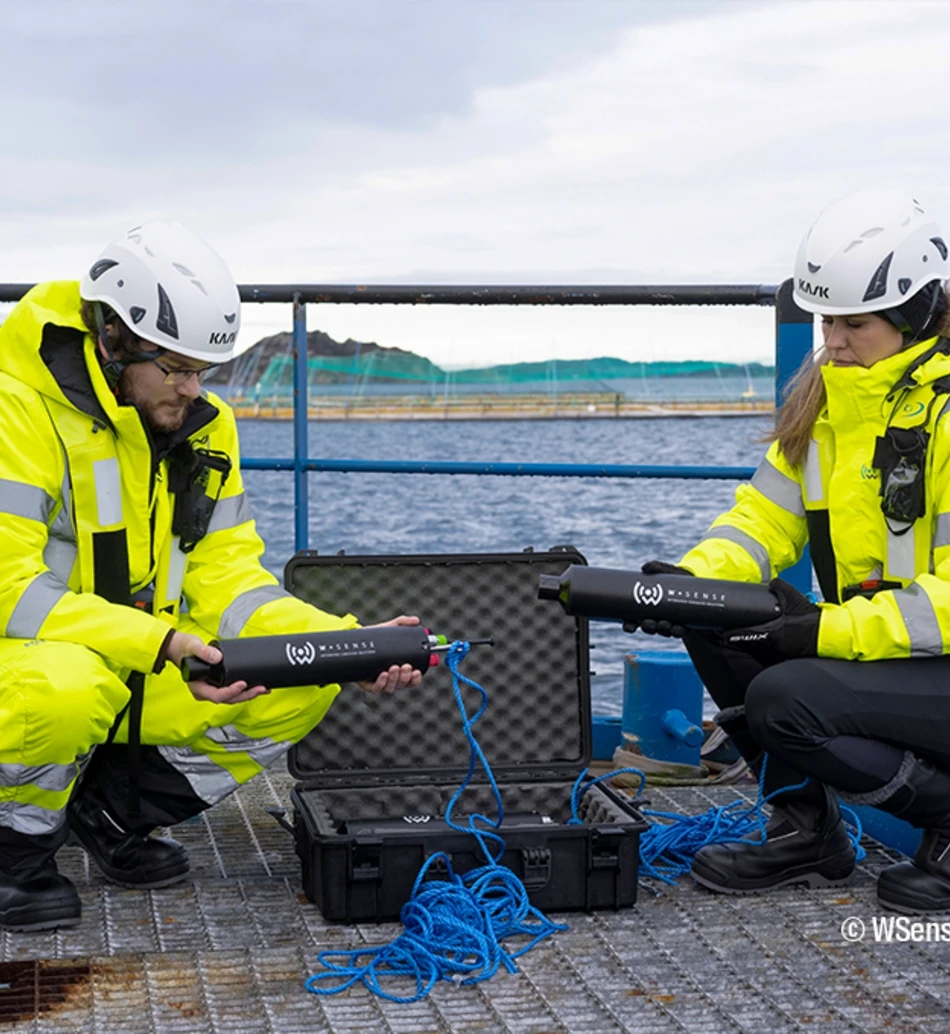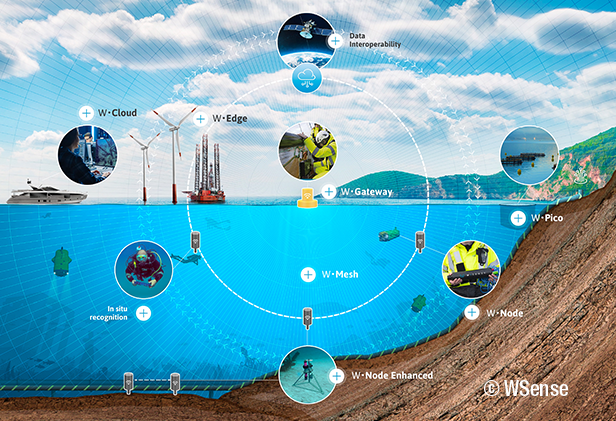Network for the big blue

Rewarded at the last World Economic Forum, Italian startup WSense has been developing a platform that could become THE solution for underwater wireless communication. It could very well revolutionize studying and understanding our planet. Interview with its CEO Chiara Petrioli.
Science thrives on data. As such, the emergence of the Internet of Things (IoT) brought about a fantastic revolution. Billions of “ intelligent objects ” packed with sensors are connected to each other and to servers, capturing and exchanging, in real time, huge amounts of data. Analysed, accessible and shareable worldwide, these data enable researchers to observe and understand our planet like never before.
Well, not all of our planet : IoT does not connect us to seas and oceans.
This blind spot is rather embarrassing. Water covers 72% of the Earth’s surface, its volumes host 80% of biodiversity and play a pivotal role in global phenomena, such as climate change. It is impossible to claim a global vision without integrating the oceans.
There are a few marine research stations scattered around the globe (like needles in algal stacks). An increasing number of intelligent marine objects have also been created (sensors, buoys, autonomous vehicles, probes…). The foundations of an underwater wireless network are also being set up, which should be as accessible and reliable as the IoT, the “ Internet of underwater things ” (IoUT). A pioneer in the field, Italian company WSense has had favourable currents this year.
The adventure of the startup began at the University of Sapienza in Rome, where Professor Chiara Petrioli is in charge of a research laboratory. “ We started looking into underwater networks 10 years ago ”, she says. “ We wanted to find a way to transmit information reliably with elements like routers in large areas. ” This research resulted in solutions “ achieving levels of reliability and performance previously not possible ” and several international patents were filed. Potential applications supported the creation of a spin-off : WSense was created in 2017 with a handful of PhDs and engineers (in the field of acoustics, network architecture, signal processing, etc.)
Today, the start-up employs a staff of fifty people with offices located in Italy, UK, and Norway. It has about twenty customers – “ Blue economy ” companies and scientific institutions. Its innovations have been honoured in 2022 by a Digital Challenge of the European Institute of Innovation and Technology and by a Blueinvest prize from the European Commission.
As you can imagine, “ wireless network ” and “ underwater ” are not made for each other. In fact, anything that makes aerial Wifi function does not work underwater. Radio waves are significantly attenuated, light or sound communication vary a lot depending on the temperature, salinity level, background noise… everything had to be reconsidered and that’s exactly what WSense has done.
Their solution is based on an innovative combination of acoustic communication for medium-range distances and optical LED technologies for short distances, with a hint of artificial intelligence.
More specifically, underwater “ nodes ” are deployed. Data transfer between the nodes is permanently optimised by AI : whenever sea conditions change, algorithms modify the path followed by byte packets.
The system, explains Chiara Petrioli, can send data to 1000 m at the speed of 1 kbit/s and up to several Mbit/s over shorter distances. This bandwidth has of course nothing to do with aerial networks “ but we are working on enlarging it ”. However, it is sufficient for transmitting environmental data collected by the sensors.
The generated network is stable, reliable, and open : a plurality of devices (sensors, probes, vehicles) of various types and brands can be connected. WSense has designed its platform first for shallow water (up to 300 m depth), but now it asserts that it is operational up to -3000 m, opening the door wider to the oceans.
On the surface, floating gateways (or posted on nearby land) connect this local network to the “ cloud ”, and so to the rest of the world – the IoUT joins IoT.
WSense designs all the software in-house (from network software to data processing) as well as all the necessary hardware: nodes, probes, modems, gateways…
By the way, its own devices are packed with sensors. “ They measure parameters such as temperature, salinity, pH, chlorophyll, methane, ammonium, phosphate, CO2, waves and tide, background noise… ” In a nutshell : everything required for real-time follow-up and extensive surveillance of submarine environments.
Aquaculture was one of the first sectors to show an interest in WSense (still key customers). The deployment of a wireless network covering the rearing cages, without multiple bulky cabling, connects everything that provides for monitoring the biotope and controlling the fish farm. Cameras and sensors, as well as robots.
An out-of-the-box diving experience
This summer, WSense will launch a miniature device : a “ micronode ” which could considerably enhance our submarine diving experience, just like smartphone applications have contributed to enriching our daily lives.
The size of a pack of cigarettes, the device is linked by cable (and LEMO W Series connectors) to a watertight tablet. Thanks to the solution, divers can communicate with the surface and among each other much better than by sign language.
“ It also makes it possible for them to receive real-time information about what they see around themselves ”, explains Chiara Petroli. For the submerged Roman ruins of Baiae for instance, the tablet could show, in augmented reality, the reconstituted buildings visited by “ diving tourists ”.
In addition, the “ micronode ” is equipped with a GPS, “ which increases safety, since the divers will always be precisely located. This option also opens new ways of exploring archaeological sites. It will be possible, for instance, to guide visitors along pre-defined itineraries. There are endless possibilities ! ”

This new product will be presented during the finish of the prestigious “ Ocean Race ” (a round-the-world sailing challenge) which will be held late June in Genoa (Italy).
“ We are in the process of developing autonomous robotic systems ”, explains Doctor Petrioli. “ We can allow teams of robots to communicate and collaborate, to send data, get instructions and change their mission in real time. ”
Following a request from a Norwegian customer, WSense R&D has recently developed an ultra-miniature fish wearable element. It makes it possible to closely observe the life and health of animals, whilst monitoring water quality. “ All this goes in the same direction : supplying tools to go further in the direction of a more sustainable fish farming. ”
Similarly, WSense’s platform can make it considerably easier to survey and work around off-shore stations, as well as underwater infrastructures, such as gas and oil pipelines.
It is just as efficient in more natural environments. The startup has deployed its network in sensitive sites and environmental hotspots. Scientists use it for instance for studying how algae, corals and animals adapt to climate change. In the field and continuously, “ which is much more precise than what we could do from the surface or satellites. ” The solution also monitors sites that represent major risks for human populations, such as volcanic areas.
The WSense platform is also deployed in archeological or cultural sites, such as the submerged luxurious Roman city of Baiae, near Naples (Italy), which is part of the UNESCO World Heritage Sites. By measuring pollution and the effects of climate change or potential damage caused by visitors, it contributes to their protection the same way as it has for a long time in the case of on-land archeological sites.
Just like webcams placed around the world, “ those connected by WSense can also promote these sites. ” They open windows for education and tourism, providing access to a larger audience than that of just scientists, companies or authorities.
The startup is also about to launch a “ micronode ” which, connected to a watertight tablet, would enhance the diving experience (see opposite page).
This new appealing product does not really embody WSense’s true ambitions. The Italian company does not only offer, unlike others, “ smart devices ”. It doesn’t want to be just one more component in our already too fragmented knowledge of oceans.
On the contrary, it wants to unite all the components.
With this in mind, WSense has ensured the interoperability of its submarine network. For the same reason, it has also been working hard on making deployment simple and reducing costs, both prerequisites for its true purpose : to define the standard for IoUT.
For this purpose, WSense must enhance its notoriety as well as its platform. In January, it got a great boost from a place that hasn’t seen any oceans for the last 200 million years : Davos, in the heart of the Swiss Alps.
During its last edition, the prestigious World Economic Forum (WEF) rewarded ten companies, including WSense, winner of its Ocean Data Challenge, an event for identifying the most promising technologies in data collection and management for ocean protection. The reward gives access to the WEF network, an ideal platform for finding people who could give support for global scale up.
There was an immediate effect : WSense spent the following weeks answering a flood of inquiries.
“ It was huge ”, says Chiara Petrioli. “ We were able to talk to political and scientific leaders, top managers, who were often unaware of the possibilities. We could explain to them that the Internet of Underwater Things was not deep tech, but a solution ready to be implemented. ”
Quick positioning on the submarine communications market is quite interesting (Forbes estimated it at 3.5 billion dollars, with a 22% increase per year). However, urgency lies elsewhere, insists Chiara Petrioli.
“ We cannot delay applying these solutions. We must not go on ignoring so many things about the exploitation of the oceans or climate change. We must understand today, because it may be too late tomorrow. ”




